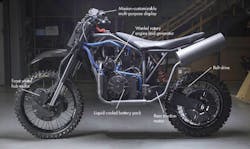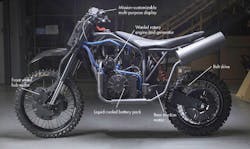Soldiers in the U.S. Special Operations, such as Navy Seals and Army Rangers, could soon see a new tool in their arsenal, silent motorcycles that will let them travel covertly farther and faster behind enemy lines, thanks to Darpa. It is funding two companies, Logos Technologies LLC and LSA Autonomy, that are each developing electric hybrid motorbikes.
Here’s a quick look at each.
The SilentHawk from Logos is electrically powered with hub motors on the front and back and wheels. The electricity can come from an onboard generator set (combustion engine and generator) or a 5.8 KWh lithium-ion battery pack. The engine can burn a variety of fuels including gasoline, propane, and petroleum-based fuels such as JP-5, JP-8, and avgas, which were originally meant for aircraft. The generator has a nominal output of 7.5 kW and a peak output of 30 kW. This is enough to give the motorcycle a top speed of 80 mph and torque of about 120 ft-lb. Using electric motors lets the bike take advantage of regenerative braking, a feature that boosts fuel economy by up to 16%. Though its range and speed will depend on the terrain and speed it is traveling, the company says the SilentHawk will travel 170 miles, which breaks down to two hours off of the batteries and the rest on the fuel-burning genset.
One goal for the designers is to have the lowest possible acoustic signature, i.e., they need to be quiet. It’s hard to sneak up on an enemy when you’re driving a Harley. And the SilentHawk seems to have succeeded with this goal. The bike puts out about 75 dB 20 ft away when it’s running on the genset, which is about the sound of a vacuum cleaner running. On batteries, the noise goes down to 55 dB, the sound level of a conversation.
The motorcycle weighs in at 350 lb, which is a bit heavy for the “lightweight” label Logos puts on it, but it should be light enough to be easily deployed by parachute. It can carry 75 lb of cargo and, I assume, a 200-lb rider.
The bike is equipped with an LED display, which could show tactical maps, status of the bike and batteries, and a host of other data. There’s also a mount and interface for an additional handheld device, most likely the Android Tactical Assault Kit (ATAK), which sounds like an Android smartphone outfitted with apps aimed at soldiers. The bike also has three power ports capable of putting out a total of 500 W.
The NightMare motorcycle from LSA Autonomy is very similar to the SilentHawk. It carries a hub motor on the front and a traction motor on the rear portion of the frame connected to the rear wheel through a whisper-quiet belt drive. The front motor is capable of putting out 17 hp/74 ft-lb peak and 11 hp/48 ft-lb continuous, while the back motor cranks out 135 hp/885 ft-lb peak and 75 hp/461 ft-lb continuous. Top speed for the 400-lb, 2WD bike is 80 mph. A Wankel rotary engine powers the generator, a choice made in part based on the low level of noise a rotary engine puts out. Overall, NightMare’s acoustic signature is much like that of the SilentHawk, 55 Db when battery-powered, 80 dB when the engine is running the generator.
The NightMare carries a one-gallon fuel tank, enough to let the bike travel 130 miles, depending on conditions and speed. The bike, like the SilentHawk, can use a variety of fuels. The liquid-cooled battery pack holds 5kWh, and a 7.5 kWh battery pack is also available. The bike can travel 60 miles on battery power alone.
It’s great that the Special Ops folks are getting an upgrade in transportation, but I wonder how much they will cost and if we’ll be smart enough to make them unusable in the hands of the enemy should U.S. forces need to leave them behind.
Looking for parts? Go to SourceESB.
About the Author
Stephen Mraz Blog
Senior Editor
Steve serves as Senior Editor of Machine Design. He has 23 years of service and has a B.S. Biomedical Engineering from CWRU. Steve was a E-2C Hawkeye Naval Flight Officer in the U.S. Navy. He is currently responsible for areas such as aerospace, defense, and medical.


